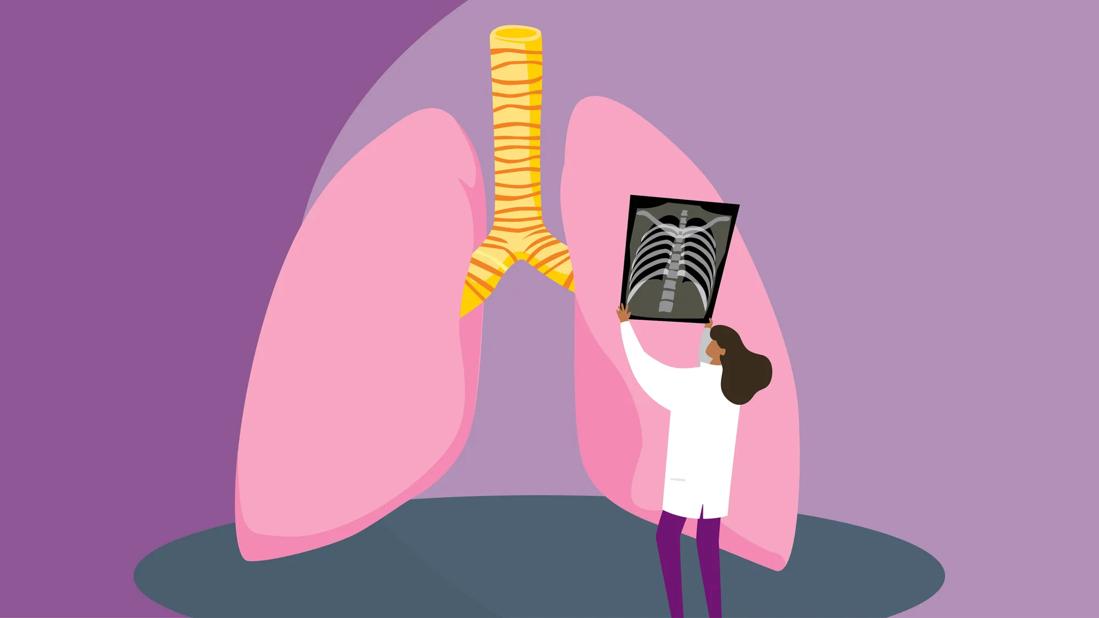Both are respiratory infections, but bronchitis affects your bronchial tubes, while pneumonia affects the air sacs in your lungs

Upper airway infections like a cold can leave your lower airways more vulnerable to viruses and bacteria, and that’s when bronchitis or pneumonia can strike. These respiratory infections share many similarities, yet they affect different parts of your respiratory system in different ways.
Advertisement
Cleveland Clinic is a non-profit academic medical center. Advertising on our site helps support our mission. We do not endorse non-Cleveland Clinic products or services. Policy
Pulmonologist Leslie Tolle, MD, explains how bronchitis differs from pneumonia and when you should seek treatment.
On the surface, it can be hard to tell the difference between bronchitis and pneumonia. The largest difference is where these infections occur:
Because pneumonia runs deep, it tends to come with more severe symptoms that affect your entire body (like chills, fever and muscle pain). Pneumonia can be life-threatening if it’s not treated or supported with care. But it’s common to also experience a milder form known as walking pneumonia, which often resolves on its own or with the help of treatment.
Bronchitis also has short- and long-term forms:
Advertisement
As bronchitis affects your upper airway, the most common symptom is a cough that may produce yellow-green mucus as your condition worsens. Other symptoms associated with bronchitis include:
Pneumonia shares a lot of the same symptoms as bronchitis but they tend to be more severe and last for longer periods of time. For example, it’s common to experience a cough for weeks after your pneumonia has resolved. And as pneumonia disrupts your body from getting all the oxygen it needs, more severe, widespread symptoms can include:
Without professional medical treatment, acute bronchitis tends to resolve on its own in just a few weeks, with the help of over-the-counter remedies that break up mucus, clear your sinuses and fight off fevers and aches. But if it’s caused by a bacterial infection, antibiotics might be the best course of action.
Chronic bronchitis, on the other hand, doesn’t fully go away on its own, and may require a variety of medications, therapies or even surgery depending on the damage that’s been done and how long you’ve had bronchitis.
Pneumonia can be treated by a healthcare provider with antibiotics (if it’s bacterial), antivirals (if it’s viral) or antifungals (if it’s a fungal infection). They may also prescribe inhalers to help you breathe easier if you’re dealing with rapid breathing or can’t take in a full breath. In many cases, it’s common to have a sore throat or cough weeks after pneumonia has resolved.
Bronchitis can turn into pneumonia if the original infection spreads from your bronchial tubes to the air sacs in your lungs. If your symptoms worsen, you have difficulty breathing or you’re short of breath, these may be signs your bronchitis has progressed farther into your lungs.
This is especially important to note because pneumonia is most harmful and life-threatening if:
If these characteristics apply to you and you’re dealing with worsening symptoms, see a healthcare provider for medical treatment right away.
Advertisement
Otherwise, you may want to consider adding the pneumonia vaccine to your list of recommended vaccines. It can help reduce your risk for bacterial pneumonia and lessen the severity of your symptoms if you were to get infected.
The bottom line? If you have symptoms that match either bronchitis or pneumonia and they don’t improve within a week, or if the symptoms keep worsening, contact a healthcare provider.
Advertisement
Learn more about our editorial process.
Advertisement

Simple solutions like adding moisture to the air and using nasal sprays can help ease your cough and other symptoms of the illness

Here's when to see a doctor about that persistent cough

Diaphragmatic breathing, pursed lip breathing and huff coughing can help manage COPD symptoms, like chest congestion and shortness of breath

Changing how you breathe, gargling water and distracting yourself are all common ways to stop your diaphragm from spasming

If you have other cold and flu symptoms, it’s probably not strep

Options like fatty fish, citrus fruits and sunflower seeds can help keep you well and heal faster

From washing your hands and disinfecting surfaces to boosting your immune health, there are many ways to reduce your flu risk

Most can return to work or school when they’re symptom-free for 24 hours

Babies can get congested easily, but you can calm their cough by keeping them hydrated, using nasal drops and running a humidifier

Weight loss may cause loose, sagging skin and muscle loss to your rear

Several conditions, like vitiligo and fungal infection, can cause a loss of pigmentation, leading to white spots or patches on your skin